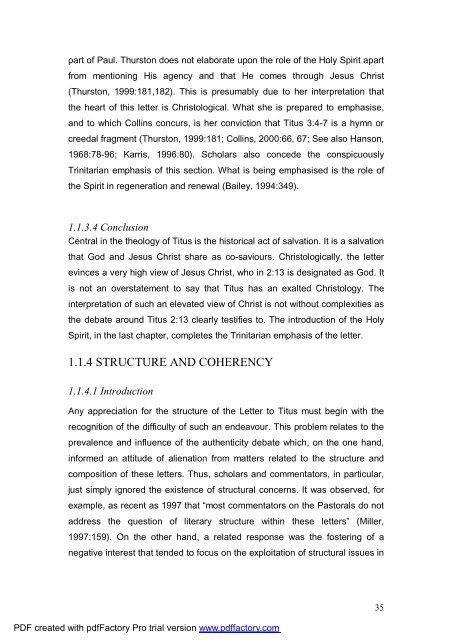A Text centred rhetorical analysis of Paul's Letter to Titus
A Text centred rhetorical analysis of Paul's Letter to Titus
A Text centred rhetorical analysis of Paul's Letter to Titus
You also want an ePaper? Increase the reach of your titles
YUMPU automatically turns print PDFs into web optimized ePapers that Google loves.
part <strong>of</strong> Paul. Thurs<strong>to</strong>n does not elaborate upon the role <strong>of</strong> the Holy Spirit apart<br />
from mentioning His agency and that He comes through Jesus Christ<br />
(Thurs<strong>to</strong>n, 1999:181,182). This is presumably due <strong>to</strong> her interpretation that<br />
the heart <strong>of</strong> this letter is Chris<strong>to</strong>logical. What she is prepared <strong>to</strong> emphasise,<br />
and <strong>to</strong> which Collins concurs, is her conviction that <strong>Titus</strong> 3:4-7 is a hymn or<br />
creedal fragment (Thurs<strong>to</strong>n, 1999:181; Collins, 2000:66, 67; See also Hanson,<br />
1968:78-96; Karris, 1996:80). Scholars also concede the conspicuously<br />
Trinitarian emphasis <strong>of</strong> this section. What is being emphasised is the role <strong>of</strong><br />
the Spirit in regeneration and renewal (Bailey, 1994:349).<br />
1.1.3.4 Conclusion<br />
Central in the theology <strong>of</strong> <strong>Titus</strong> is the his<strong>to</strong>rical act <strong>of</strong> salvation. It is a salvation<br />
that God and Jesus Christ share as co-saviours. Chris<strong>to</strong>logically, the letter<br />
evinces a very high view <strong>of</strong> Jesus Christ, who in 2:13 is designated as God. It<br />
is not an overstatement <strong>to</strong> say that <strong>Titus</strong> has an exalted Chris<strong>to</strong>logy. The<br />
interpretation <strong>of</strong> such an elevated view <strong>of</strong> Christ is not without complexities as<br />
the debate around <strong>Titus</strong> 2:13 clearly testifies <strong>to</strong>. The introduction <strong>of</strong> the Holy<br />
Spirit, in the last chapter, completes the Trinitarian emphasis <strong>of</strong> the letter.<br />
1.1.4 STRUCTURE AND COHERENCY<br />
1.1.4.1 Introduction<br />
Any appreciation for the structure <strong>of</strong> the <strong>Letter</strong> <strong>to</strong> <strong>Titus</strong> must begin with the<br />
recognition <strong>of</strong> the difficulty <strong>of</strong> such an endeavour. This problem relates <strong>to</strong> the<br />
prevalence and influence <strong>of</strong> the authenticity debate which, on the one hand,<br />
informed an attitude <strong>of</strong> alienation from matters related <strong>to</strong> the structure and<br />
composition <strong>of</strong> these letters. Thus, scholars and commenta<strong>to</strong>rs, in particular,<br />
just simply ignored the existence <strong>of</strong> structural concerns. It was observed, for<br />
example, as recent as 1997 that “most commenta<strong>to</strong>rs on the Pas<strong>to</strong>rals do not<br />
address the question <strong>of</strong> literary structure within these letters” (Miller,<br />
1997:159). On the other hand, a related response was the fostering <strong>of</strong> a<br />
negative interest that tended <strong>to</strong> focus on the exploitation <strong>of</strong> structural issues in<br />
PDF created with pdfFac<strong>to</strong>ry Pro trial version www.pdffac<strong>to</strong>ry.com<br />
35

















